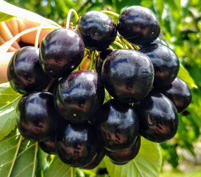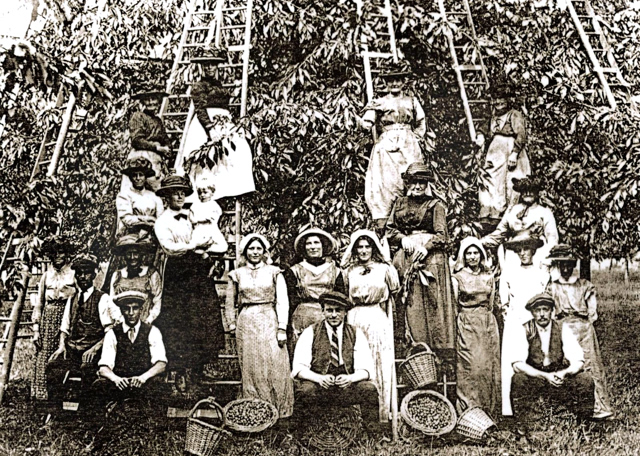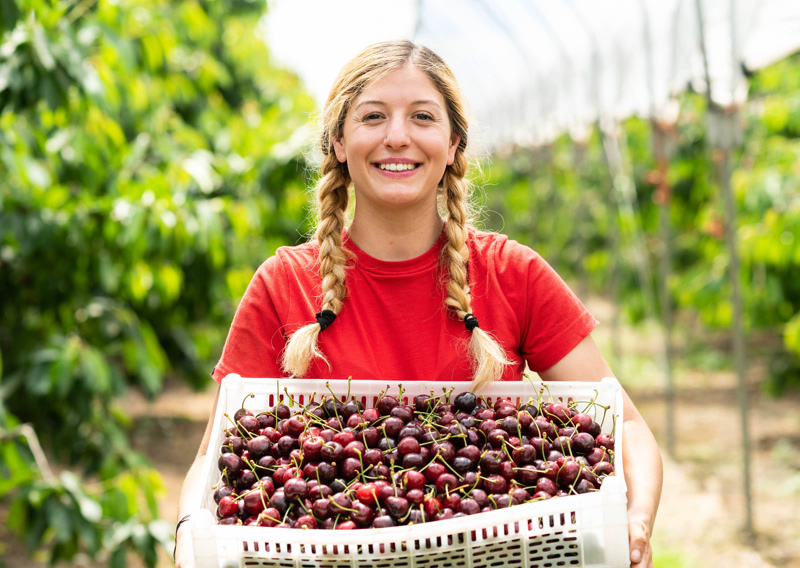

 The world of British Cherries has changed considerably over the last 25 years and 'exponentially' over the last 10 years.
The world of British Cherries has changed considerably over the last 25 years and 'exponentially' over the last 10 years.
The change from the large cherry trees which bestrode the Garden of England in the 19th century, extending well into the 20th century, started when growers moved from those very tall trees onto smaller trees grown on dwarfing rootstocks. The semi-dwarfing Colt rootstock arrived in 1970's enabling smaller trees, but due to it's characteristic need for adequate winter chill, often (most often) failed to produce a commercially worthwhile crop.
Cherries were always at risk of splitting when rain fell during harvest time, birds which were discouraged by minders wandering through the cherry orchard with shot guns in days gone by, were gradually replaced by 'bird netting'
25 years ago, forward thinking growers erected 'bird nets and plastic covers' over their Colt grown cherries, but not until the emergence of 'dwarfing Gisella rootstocks' which didn't require the level of winter chill and by their nature much more precocious cropping, did the modern cherry industry really take off!
In this week's English Apple Man Journal we celebrate the British Cherry and the fact that this season (an early one) has produced cherries from early June and will continue into early September.
While the first British Cherries did not arrive on Supermarket shelves until the 3rd week of June, early sites in Southern England were picking in early June and roadside stalls were selling the succulent Cherries we all love!
Scottish Cherry growers are confident of harvesting into September.
How it used to be!
Cherries were introduced into England at Teynham, near Sittingbourne in Kent, very nearly 500 years ago, by order of Henry VIII, who had tasted them in Flanders.
 Cherry Pickers circa 1900's and memories of a young cherry picker.
Cherry Pickers circa 1900's and memories of a young cherry picker.
"In Iwade there were lots of cherries years ago, I was only 16 and went ladder moving for the women, the ladders were 65 stave ladders and very heavy to balance. The biggest trees were Gauchers, there was also Early Rivers, Bradbourne Blacks, Frogmores, Naps, etc.
I was very shy and the women soon cottoned on to that and spent all day taking the mick and telling naughty stories making me go so red, (there were no toilets), the worst lot were the Chatham gang! I hated it. I liked being given the gun and cartridges to keep the starlings off best.
Like most temperate-latitude trees, cherry trees require a certain number of chilling hours each year to break dormancy and bloom and produce fruit. The number of chilling hours required depends on the variety/rootstock combination.
Purely by chance the semi-dwarfing rootstock "Colt" was introduced in 1971 which enabled cherry trees to be restricted to a reasonable height for picking and protection against birds.
The combination of the Colt rootstock and and the self-fertility of Stella took the cherry "world" by storm. In reality, during the 1970s and early 80s there was no sensible alternative to Stella grown on Colt rootstock for the amateur gardener.
Gisela Series, a dwarfing rootstock that produces trees significantly smaller than others, only 8 to 10 feet (2.5 to 3 meters) tall arrived in the 1990's.
Gisela 5 is a variety of cherry (Prunus cerasus) obtained by Doctor Gruppe in Giessen (Germany ). It was obtained thanks to the crossing of Schatten Morelle (Variety of Guindo) x Prunus Canescens (Cano Cherry or Gray Leaf Cherry).
Registered in 1997, Gisela 5 is under patent or commercial registration until 2027.
Below: Cherry picking in 2020

The English Apple Man is very grateful for the support of Love Fresh Cherries the promotional body of British Summer Fruits for providing an overview of this season and the nutritional benefits of cherries.
Love Fresh Cherries
British cherry harvest and UK growers are set for an encouraging cherry season with around 6,000 tonnes of home-grown British cherries predicted to hit supermarket shelves this summer, broadly similar to last year's harvest.
 The figures are from Love Fresh Cherries, the largest representative trade body for British cherries in the UK. Love Fresh Cherries is predicting good availability for consumers throughout the British season as conditions have been favourable over the winter months, as well as spring, leading growers to anticipate a high-quality crop across most varieties too.
The figures are from Love Fresh Cherries, the largest representative trade body for British cherries in the UK. Love Fresh Cherries is predicting good availability for consumers throughout the British season as conditions have been favourable over the winter months, as well as spring, leading growers to anticipate a high-quality crop across most varieties too.
This year's crop represents a six-fold increase on 2010's figures, when 95 per cent of cherries in British supermarkets were flown in from overseas.
Fearing that traditional home-grown crops were being lost to bland imports and tasteless modern varieties, growers launched a campaign to revitalise their industry, with more than 6,000 tons expected to be harvested this season, with the excess being sold to Hong Kong, Malaysia, Oman, Qatar and South Africa.
Despite the unusually warm weather in spring, a few late frosts, in May, are expected to have an impact, particularly on the Kordia variety. This year's British cherry harvest began at the end of June, a week earlier than last year thanks to crops coming on slightly faster through this year's very warm spring.
Matt Hancock, Love Fresh Cherries spokesperson, said, "Cherries are the quintessential English fruit; they not only taste great but offer a whole host of fantastic health benefits which are helpful generally, but perhaps even more so at a time when nutrition and health is a focus for us all.
"There has been a well-publicised cherry shortage across Europe this year. With all indications positive for a strong UK cherry season it means people across the country and beyond will be able to enjoy, British home-grown cherries at their peak."
Rob Hobson, Love Fresh Cherries nutritionist, added, "Fresh cherries are low in calories, enormously versatile and are an abundant source of vitamins, minerals and antioxidants that can help boost your immune system. "With just one cup of cherries providing almost 20% of your recommended daily amount of Vitamin C, cherries are a fantastic way to nourish yourself between meals and contribute to a healthy diet."
The English Apple Man Summarises
While British Cherries extend back nearly 500 years, the last 25 years has seen a quantum leap forward to a new era of very high quality production of this superb fruit.
On a global scale our 6,000 tonnes does not get anywhere near the scale of the top volume producers, however in terms of quality and eating satisfaction, British is Best!
Global cherry tonnages (as of 2014)
1. Turkey - 445,556. 2. United States - 329,852. 3. Iran - 172,000.
Below: Link to Berry Gardens Cherries and two Links to English Apple Man Journals from the past covering British Cherries
Click on: BERRYGARDENS CHERRIES to visit some of the growers from the South of England to Perthshire in Scotland
Click on: Growing Cherries in King Henry V111 orchards
Click on: CHERRIES 2019 for a look at a large scale Cherry operation in Kent.
That is all for this week
Take care
The English Apple Man